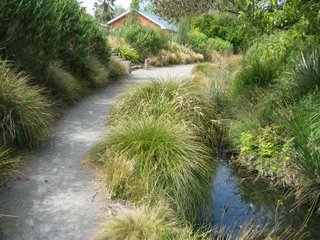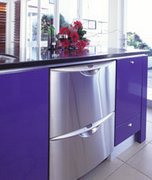For the past two weekends, I have been taking my bicycle up the Port Hills which lie just to the south of Christchurch. The hills are 1300 feet high and the climb up the hills has been either up a steep, winding road that goes to the top or up a dirt trail that is a little further east of the road. From the top, the plain in which Christchurch sits spreads out before you as it climbs to meet the line of snow-covered mountains 30 miles distance. To the east lies the Pacific Ocean. To the South is Lyttleton Harbor, the primary port of the Canterbury region. On the other side of the harbor is the Banks Peninsula which is basically a sunken volcano. Along the top of the hills is a road called Scenic Drive that allows people to check out the sites from their cars. There are also lots of walking trails, cycling trails and multi use trials all through the area which is mostly parkland. It is amazing to see how many people are out walking, running or cycling in the hills on a Saturday morning.
A few weeks ago, I went up to the summit with German friends from Ilam Village where I live. One of the Germans had just bought a car for $700 (US $420) and we took it up the hill to celebrate. We planned to do a bit of tramping (Kiwi for hiking), but first we stopped for coffee and cake at a café on the top of the hill. We set out for a short tramp with great views of the harbor and finished with another visit to a café at the end and ice cream. I like tramping with Germans.
On the trips up the hills on my bicycle, I have ridden along the trails that parallel the road on the top of the hills. It is so beautiful up in the hills with the blue skies, fluffy clouds, the cool breeze, the friendly people all of who say hi as you pass and the mountains in the distance. (who wouldn’t be in a friendly mood in such a fantastic place?) The hills are mostly covered with grass with trees lower down. The grass is tussock which tends to grow in large clumps. Sheep graze the hills and wire fences line the road to keep the sheep in their area. To access the hiking or biking trails, you have to either climb up steps over the fence or ride over a metal grate over a pit. The sheep cant cross the grate because their legs get stuck between the bars.
The clumps of grass are actually a pain while biking.  I will be going along and one of my pedals will hit a clump, causing my bike to stop. (An example of the tussok is in the photo to the right). The problem is that even though the bike has stopped, my body keeps going and it is all that I can do to stay on the bike as both my feet launch off the pedals and my stomach heads for the handlebar stem as I am lifted off the seat. Needless to say, I am a bit wary of riding fast when I come to such dreadful stops with some regularity, but seeing as the other cyclists cruise along, there must be a trick to avoiding the hazards that I have yet to learn.
I will be going along and one of my pedals will hit a clump, causing my bike to stop. (An example of the tussok is in the photo to the right). The problem is that even though the bike has stopped, my body keeps going and it is all that I can do to stay on the bike as both my feet launch off the pedals and my stomach heads for the handlebar stem as I am lifted off the seat. Needless to say, I am a bit wary of riding fast when I come to such dreadful stops with some regularity, but seeing as the other cyclists cruise along, there must be a trick to avoiding the hazards that I have yet to learn.
There are several downhill mountain bike tracks from the top of the hills. I took a look at one of these in expectation that I could ride it and instead kept going past. It was called the Lava Flow and it was insanely steep and with rocks all over. There is another part of the reserve called Victoria Park and it is home to crisscrossing trails which I decided to try. The trails are dirt and plunge into the tree line below the summit. Straightaway, I came to a part of the trail that was beyond my current level. A jogger was coming and so I pulled over to let him past. He called out that the trail looked a lot worse than it was. Sure, I thought. I realized that I was in trouble when everyone else on the trail that I saw had BMX helmets, knee pads and specially designed downhill bikes that looked like tanks with full suspension. I made it down with some hesitations and a lot of braking to a clearing in the woods. Here I found jumps for BMX or mountain bikes. There were a lot of trails departing from the clearing and as it was my first time on the trails, I did not realize that the trails were marked by difficulty. I inadvertently chose a black diamond which is the hardest. The most insane thing about it was that on the really steep parts, the trees are covered with carpet. Not that the carpet will help stop the rider who hits the tree, but I suppose that it is a lot nicer to get rug burns than to be torn apart by the bark. As I made my way down, I came upon warning signs that a 40 ft jump was coming up. Sure enough, there was a ramp going up and 40 feet away there was a ramp going down. I couldn’t imagine such jumps in a US park because it would be a lawsuit waiting to happen.
Anyway, I made it down in one piece. I tried the trails again the following week with a friend from Christchurch who rides the hills every week. He was a lot better than I am but fortunately we stayed on the blue trails which were less crazy. I really like biking up the hills and once I master the pedal obstacles, I think it will be a lot of fun.
One thing about Christchurch that catches me off guard when I see it is bare feet. Mind you, most people that I meet wear shoes, but every now and then you see people at the grocery store, at school or at church wandering about in bare feet. A lot of other people wear Jandals which is a Kiwi word for flip-flops (New Zealanders are called Kiwis). Jandals, Flip Flops, thongs or whatever you call them are rumored to have actually been first created by a kiwi in New Zealand in the early 1930s. However, that is the rubber version that can be seen all over. The true origin of the sandal was Japan where they have been wearing different versions for thousands of years. Hence, the Kiwi word Jandals is derived from Japanese Sandals.
This past Sunday, I went to my friend Titus’s house for lunch. After lunch, we were cleaning up the dishes when I discovered the neatest dishwasher that I have ever seen.  Actually, it was a dishdrawer, not a dishwasher. It is the same height as a traditional dishwasher in the US, but it is split into two halves along its height. Each half of the dishwasher, is actually a separate dishwasher itself. Titus told me that these are now quite popular in New Zealand and have accounted for the bulk of dishwasher sales over the past five years. The popularity is due to the fact that you don’t need a huge amount of dishes to run the dishwasher. I rarely ran my dishwasher in Baltimore because I had to plan to fill it. But with the Fisher & Paykel Dishdrawer, you can easily run a small load. You only need half the dishes to fill a drawer as it would take a full size dishwasher. Or, if you have a lot of dishes, you can fill the top and bottom drawers. Or, if you have people over for a meal and you
Actually, it was a dishdrawer, not a dishwasher. It is the same height as a traditional dishwasher in the US, but it is split into two halves along its height. Each half of the dishwasher, is actually a separate dishwasher itself. Titus told me that these are now quite popular in New Zealand and have accounted for the bulk of dishwasher sales over the past five years. The popularity is due to the fact that you don’t need a huge amount of dishes to run the dishwasher. I rarely ran my dishwasher in Baltimore because I had to plan to fill it. But with the Fisher & Paykel Dishdrawer, you can easily run a small load. You only need half the dishes to fill a drawer as it would take a full size dishwasher. Or, if you have a lot of dishes, you can fill the top and bottom drawers. Or, if you have people over for a meal and you are ready to serve dessert, you can be taking clean dishes right out of the top portion to use for dessert while putting the dirty dishes into the bottom section. My friend told me that you can buy one drawer if you don’t need two halves of a dishwasher. Pretty ingenious idea. Check out the one photo of the dishdrawers where they look like they are identical to the drawers in the cabinet. Pretty slick. Oddly enough, the company that makes the dishdrawer is also a healthcare company.
are ready to serve dessert, you can be taking clean dishes right out of the top portion to use for dessert while putting the dirty dishes into the bottom section. My friend told me that you can buy one drawer if you don’t need two halves of a dishwasher. Pretty ingenious idea. Check out the one photo of the dishdrawers where they look like they are identical to the drawers in the cabinet. Pretty slick. Oddly enough, the company that makes the dishdrawer is also a healthcare company.
I have seen other neat appliances here as well.  One is the WhisperGen which is a combined boiler / generator and is the size of a dishwasher (or two dishdrawers!). Running on natural gas, the WhisperGen provides the hot water for the house and any excess electricity that is produced can be fed back into the electricity grid or used in the home, reducing electricity costs. In addition to the home version, there is also a marine version that can be used to provide hot water and electricity on a boat.
One is the WhisperGen which is a combined boiler / generator and is the size of a dishwasher (or two dishdrawers!). Running on natural gas, the WhisperGen provides the hot water for the house and any excess electricity that is produced can be fed back into the electricity grid or used in the home, reducing electricity costs. In addition to the home version, there is also a marine version that can be used to provide hot water and electricity on a boat.
The one appliance you don’t see too often in a house is a furnace. I am learning that a lot of houses in Christchurch don’t have central heating. Friends of mine who live in flats off campus keep electric space heaters running during the winter to stay warm. Other people use wood fires to keep warm. The lack of heat and the cost of running space heaters is why a lot of students like to move on campus during the winter where heat and electricity is included in the cost of the room. However, that can make living on campus far more expensive (double the cost in some cases) than living in a flat off campus. For what I pay per week (all rents here are per week, not per month) for my room in a five person flat, I could rent an entire, unfurnished house in the suburbs. That is not to say that the houses in Christchurch are inexpensive. On the contrary, the city has experienced the same soaring real estate prices as elsewhere and small homes can cost over $200,000. And when I say small, I mean square, one story houses with two bedrooms and small gardens (yards).
One location that can really use a furnace are the vineyards to the north of Christchurch. New Zealand has a wine industry with vineyards on the South Island that tend to grow Sauvignon Blanc, Chardonnay and Pinot Noir grapes. To be honest, I never saw a bottle of New Zealand wine in the US (but I wasn’t looking) and I have yet to try it here in the country because the Australian wines are less expensive. The problem that the vineyard owners face right now is frost. One night of frost will damage the harvest for not one, but two seasons which is a blow to profits. Tens of millions of dollars in lost production was attributed to frost burn in 2004. To prevent this, the vineyard owners hire fleets of helicopters from all over the country to hover over their vineyards. There are thermometers throughout the vineyard and when the temperature in one are drops too low, a light on a pole above the vines turns on, alerting the helicopter pilots to the dangerously low temperatures in the area. The helicopter pilot then swoops in and hovers about 20 feet off the ground to mix the air with the rotor blades which effectively raises the temperature on the ground. On a given night, you can have over 80 helicopters flying over the winery region at a cost between $650 to $2000 per hour. But compared to the loss of two seasons harvest, this cost is small. What is amazing is that with so many helicopters in the area over a small area, all of them swooping to the ground as the lights turn on, there have not been any collisions. I think that it would be really neat to sit and watch this all happening one night.



No comments:
Post a Comment